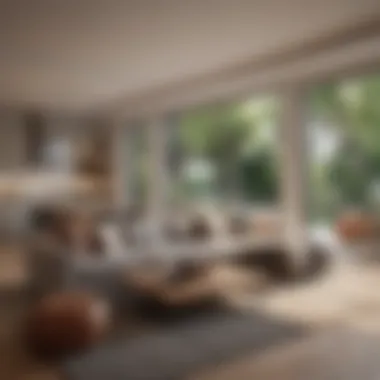Mastering Square Footage Calculations for Homes


Intro
Understanding how to calculate square footage can greatly impact your decisions as a homeowner. This involves more than just knowing the number of square feet; it affects how you value your home, how space is utilized, and your overall real estate choices.
In this guide, we aim to simplify the process of determining square footage while covering essential concepts that will empower you. By examining various methodologies and addressing common challenges, you'll gain a practical toolset for both current and future property endeavors.
Home Features
When calculating square footage, it is vital to consider the various home features that influence measurement. This overview will delve into architectural styles and interior design trends relevant to homeowners.
Architectural Styles
Architectural styles impact the way square footage is calculated. Differences in design can result in unique floor plans and usable areas. For instance, a traditional Colonial home often features defined rooms, which may lend itself to straightforward measurement. In contrast, an open-concept layout commonly found in contemporary homes might require more careful assessment of shared spaces.
Each architectural style presents its own challenges and opportunities:
- Craftsman: Known for built-in furniture, which might affect how you measure usable areas.
- Victorian: Often features nooks and crannies that necessitate detailed calculations.
- Modern: Open spaces invite creativity but require precise dimensions for accurate square footage.
Interior Design Trends
Interior design trends can also impact how square footage is perceived and calculated. Homeowners today often favor minimalism, which emphasizes open spaces. This can alter the way spaces are defined, complicating traditional methods of measurement.
Factors to consider include:
- Multi-functional Spaces: Rooms that serve several roles need careful consideration of usage for accurate square footage.
- Built-In Features: Cabinetry or shelving can affect available space and require adjustments in measurement.
- Furniture Layout: The way furniture is arranged can influence how open and usable a space feels, potentially affecting property value.
"Determining square footage is not just about numbers; it’s about understanding how to utilize space effectively."
By recognizing these features and trends, homeowners can gain insights into the accurate calculation of square footage, leading to improved valuations and practical space management.
Culmination
With a solid grasp on home features and their implications on square footage calculation, you can make informed decisions regarding property values and space utilization. The next sections will delve deeper into specific measuring techniques and practical examples, equipping you with the knowledge needed for accurate assessments.
Understanding Square Footage
Understanding square footage is crucial for homeowners and potential buyers alike. This concept has significant implications on property valuation, renovation, and design. When homeowners have a clear grasp of square footage, it aids in making informed decisions about buying, selling, and improving their properties. The calculations affect factors like pricing and usability of spaces. Moreover, accurate measurements can help avoid conflicts in the real estate market, especially during sales negotiations.
Definition of Square Footage
Square footage refers to the total area of a home or room measured in square feet. To compute square footage, one typically measures the length and width of a space and multiplies these numbers. For example, if a room is 10 feet wide and 12 feet long, its square footage is 120 square feet (10 x 12). This straightforward calculation provides a baseline for understanding the size of living spaces.
Importance of Accurate Measurements
Accurate measurements directly impact property valuation. When homeowners understand the precise square footage of their property, it assures a fair market price. Incorrect measurements may lead to inflated or deflated property values, creating complications in real estate transactions. Furthermore, certain applications such as interior design benefit from precise calculations. A designer needs specific measurements to create functional and visually appealing spaces. Inconsistent or incorrect data can lead to issues in planning and executing renovation projects.
Accurate square footage measurement can enhance the functionality of a space and ensure that a homeowner's investment is protected.
In summary, understanding square footage is not merely academic; it has real-world consequences for homeowners. This section sets the stage for further exploration into the tools and techniques that can help in measuring square footage effectively.
Tools Required for Measurement
Accurate measurement is critical when calculating square footage. This section focuses on the tools that can facilitate this process, breaking them down into two main categories. An understanding of these tools can lead to superior outcomes in project accuracy and efficiency. Every homeowner should have a fundamental grasp of what tools are available and which best suits their needs.
Basic Measuring Tools
Basic measuring tools are essential for any property owner. They allow homeowners to derive accurate measurements without needing advanced technology. Common tools include:
- Tape Measure: This is the simplest yet most effective tool. It is flexible, allowing it to navigate around corners and edges. A standard tape measure can typically extend to 25 feet or more, providing ample reach for most home dimensions.
- Ruler or Yardstick: While not ideal for larger rooms, a rigid ruler is helpful for smaller areas or for precision work. It can also assist in measuring furniture or moldings.
- Level: Not directly a measuring tool, but crucial for ensuring that any surfaces are indeed level when installed. This is particularly useful for measuring floors in basements or attics where uneven surfaces might affect overall square footage calculations.


Using these basic tools, a homeowner can effectively measure and calculate square footage with relative ease. Understanding the purpose of each tool can streamline the process.
Advanced Digital Tools
For those who seek precision beyond what traditional tools can offer, advanced digital tools are increasingly popular. They provide accuracy and often come with enhanced functionalities. Some noteworthy tools include:
- Laser Distance Measure: This device uses laser technology to determine distances quickly. The user points the laser at a wall, presses a button, and receives an instant reading. Many models store multiple measurements which can be useful for complex projects.
- 3D Scanning Devices: Some homeowners opt for advanced 3D scanners. These devices create digital models of spaces, capturing detailed measurements of every nook and cranny. This can be invaluable in irregular floor plans.
- Smartphone Apps: With the rise of mobile technology, many applications now help measure spaces using your phone's camera. These apps can calculate square footage and even create layouts, making them a convenient option for tech-savvy homeowners.
In summary, using a blend of basic and advanced tools ensures accuracy and efficiency in measuring square footage. By investing in the right tools, homeowners can avoid common pitfalls associated with measurement.
Understanding the available tools enables homeowners to choose the best method suited for their specific needs. Whether opting for basic measuring instruments or advanced digital solutions, the end goal remains the same: accurate square footage calculations.
Preparing for Measurement
Preparing for measurement is a critical step in calculating square footage. An effective approach before diving into the measuring process ensures accuracy and saves time. It involves thoughtful planning and organization. Those who prepare adequately can avoid common pitfalls. This preparation enhances the overall outcome of the square footage calculations.
Creating a Layout Plan
Creating a layout plan is an essential task in preparing for measurement. This plan outlines the entire area to measure, ensuring no part is overlooked. Begin by sketching the property or room on paper. Include walls, doors, and windows. This will provide a clear visual reference.
A thoughtful layout plan can include:
- Room Dimensions: Draft each room on the layout, noting its length and width.
- Architectural Features: Indicate elements like built-in shelves, alcoves, or sloped ceilings.
- Reference Points: Mark locations for doors and openings, which may affect measurements.
Having this information at hand minimizes errors related to miscalculation. With a well-drafted plan, homeowners can measure confidently, ensuring all critical areas are accounted for.
Clearing the Area to Measure
Clearing the area to measure is another important consideration. An unobstructed space allows for precise measurements. Before starting, remove any furniture, decor, or other items that may block access to walls or corners. This helps to gather accurate data on the floor dimensions.
Also, take into account:
- Safety: Ensure that the area is safe to navigate; hazards can lead to injuries or measurement errors.
- Flooring Types: Different flooring materials may affect the measurement technique—the smoother the surface, the easier it is to measure accurately.
- Lighting: Good lighting can improve visibility, which assists in ensuring that all dimensions are clear and visible.
A clean and open space not only facilitates measurement but also prevents frustration during the process. Following these practices contributes significantly to obtaining an accurate calculation of square footage.
Measuring Techniques
Understanding measuring techniques is crucial in ensuring accurate square footage calculations. Accurate measurements prevent potential issues in valuation and space management, affecting everything from property listings to renovation plans. Utilising the right techniques contributes to getting results that truly reflect the property's dimensions.
Linear Measurement Method
The linear measurement method involves taking direct measurements of the space using a tape measure. This method is preferred for its simplicity and effectiveness. Start by measuring each wall in a room. Record the length of each wall, and ensure to measure at a consistent height, usually about three feet from the floor. This technique helps in obtaining precise data for each dimension. Smaller details like alcoves and recesses can be noted as well, to ensure completeness.
Area Calculation for Rectangular Spaces
Once linear measurements are taken, calculating the area of rectangular spaces becomes straightforward. Multiply the length by the width. For example, if a room measures 12 feet in length and 10 feet in width, the calculation would be:
[ \textArea = \textLength \times \textWidth = 12 \textft \times 10 \textft = 120 \textft^2 ]\
This formula can be further adapted for combining multiple rectangular spaces in larger rooms or connected areas. One key detail to remember is to always convert measurements into the same units before calculating.
Calculating Irregular Floor Plans
Irregular floor plans present a unique challenge. To address this, one effective technique is to divide the area into manageable geometric shapes like triangles and rectangles. Calculate the area of each section separately, then sum the results for a total.
For instance, you can divide an irregular room into a rectangle and a triangle. Calculate each part:
- For the rectangle: If it measures 10 feet by 8 feet, the area is 80 square feet.
- For the triangle: If the base is 5 feet and the height is 4 feet, the area is [ \frac12 \times 5 \times 4 = 10 \textft^2 ].


Finally, combine the areas: 80 square feet + 10 square feet = 90 square feet in total.
Every technique presents specific benefits and considerations. Whether using linear measurements for simplicity or breaking down complex shapes into smaller parts, accuracy in measuring techniques is essential for reliable square footage calculations.
Understanding Different Types of Square Footage
Understanding the distinction between various types of square footage is essential for homeowners and real estate professionals. The measurements directly affect how properties are valued, how much space is truly usable, and ultimately, how a buyer perceives a home. Different types of measurements cater to specific needs, whether one is evaluating property for buying, selling, or enhancing the livability of a space.
Clear comprehension of square footage types allows for accurate assessments of property value and informed renovation decisions. It also helps potential buyers understand what they are actually getting in terms of space. A misinterpretation can lead to disappointing outcomes when moving in or planning for future developments.
Gross vs. Usable Square Footage
When discussing square footage, distinguishing between gross and usable square footage is crucial.
- Gross Square Footage includes all areas of a property, both livable and non-livable. This measurement is essential for understanding the total size of the building. It covers areas such as walls, hallways, and even foundations. However, gross square footage can be misleading if the focus is only on usable space.
- Usable Square Footage, on the other hand, refers to the space that can actually be utilized by inhabitants. This includes rooms like living rooms, bedrooms, and kitchens, but excludes unoccupied areas such as utility rooms and thick walls.
The difference can be significant; knowing the usable space helps homeowners plan furniture layouts and ascertain how functional the home is. It is very important to ask for both measurements when evaluating real estate properties.
Living Space Measurements
Living space measurements focus solely on areas where people spend their time. This is valuable for assessing comfort and usability. Living spaces include:
- Bedrooms and living rooms: Where families gather and relax.
- Kitchens: The heart of the home, requiring adequate square footage for movement and appliance usage.
- Bathrooms: Sizing matters for functionality and comfort.
Understanding the total living space gives an insight into the property's capacity to meet the needs of its occupants. Buyers often prioritize this metric when considering options, emphasizing the practicality of the environment in which they will live.
Non-Livable Areas
Non-livable areas, as the name implies, do not serve as functional spaces for everyday living. These are critical to consider in the overall assessment of square footage, as they can significantly impact the effective use of the home. Common non-livable spaces include:
- Garages: Though often used as storage, garages do not contribute to living space.
- Basements: Not all basement areas are finished or usable, so only the parts that are livable should count.
- Attics: Similar to basements, attics require proper finishing to serve as living space.
If a homeowner or buyer fails to account for non-livable areas, decisions on the property's value or potential renovations may become skewed. Understanding what counts as livable versus non-livable can guide practical choices regarding purchasing or upgrading a home.
"Accurate square footage calculations can lead to better decisions in real estate and design, converting spaces into true reflections of personal needs."
Calculating Square Footage for Specific Areas
Calculating square footage for specific areas in a home is crucial for various reasons. First, it aids homeowners in understanding their living space and its potential uses. Correct measurements can significantly impact decisions in real estate transactions, renovations, and personal space management. Knowing the square footage of certain areas allows homeowners to plan better for renovations, identify any needed repairs, and optimize both functional and aesthetic aspects of their homes.
When measuring areas like rooms, basements, attics, and outdoor spaces, it is important to approach each type with the right methods. Each area has specific dimensions and features that influence how square footage is calculated.
Rooms and Living Spaces
Rooms and living spaces are usually the most straightforward when calculating square footage. These areas are often rectangular or square, making the measurement process simple. Homeowners should start by measuring the length and width of each room. The formula to find the square footage is simply length multiplied by width. For example, a room that is 12 feet by 10 feet has a total square footage of 120 square feet.
The importance of measuring these spaces accurately cannot be overstated:
- Property Valuation: Square footage of living spaces can affect market value; larger homes typically sell for more.
- Space Planning: Understanding dimensions helps in arranging furniture efficiently and identifying how to utilize the area best.
- Design Decisions: Knowing the square footage allows homeowners to select the right finishes and design elements that fit the space.
In addition to basic measurements, special consideration should be taken for features like alcoves and built-ins. These can affect usable space but may not always be included in total square footage.
Basements and Attics
Basements and attics can present additional challenges in square footage calculations. These areas may be less straightforward due to varying ceiling heights and shapes. For basements, if the space is finished, it can be included in the total square footage calculation. For instance, measure the length and width of the finished area just as you would for any room. For unfinished areas, note the square footage but recognize it may hold less value in terms of livable space.
In attics, the presence of slanted walls and ceiling heights complicates the task. Usually, only the areas with a minimum height of 7 feet may be counted towards the livable square footage. It is important to:
- Measure Carefully: Utilize a laser measure or measuring tape to account for slanted ceilings.
- Distinguish Usable Areas: Clearly mark usable versus non-usable areas to understand what counts as livable square footage.


Outdoor Spaces
Outdoor spaces also play a role in square footage calculations, especially in urban areas where outdoor living is valuable. Patios, balconies, and decks can enhance a property's appeal and provide additional recreational spaces. When measuring these areas, it is important to note the dimensions and keep the following in mind:
- Functionality: Consider how these spaces will be used and their importance to the overall property.
- Impact on Value: Outdoor spaces can increase a property’s valuation; well-measured areas can play a part in marketing effectively.
- Access and Safety: Ensure the space is accessible and safe when measuring, identifying features like stairs or railings that may affect usability.
Measuring outdoor spaces may require different tools, like a long measuring tape or a wheel measure, to help manage larger areas efficiently.
Accurate square footage calculations for specific areas enhance real estate value and maximize living potential within a home.
Taking the time to understand how to measure and calculate square footage in distinct areas leads to informed choices, enhancing both the homeowner's experience and property investment.
Common Errors in Square Footage Calculation
Calculating square footage accurately is not just a trivial task; it can significantly affect property valuation and usability. Errors can lead to misunderstandings about the actual size of a home or space. This section addresses common mistakes that can occur during calculations and offers insights into how to avoid them. Recognizing these pitfalls empowers homeowners and real estate professionals to make informed decisions and enhances their property management skills.
Overlooking Architectural Features
One of the prevalent errors in square footage calculation is overlooking architectural features. These can include built-in elements like shelves, recesses, or alcoves that may alter the total area. Failing to account for these features can lead to inaccurate measurements. Homeowners might only measure wall-to-wall distances without considering that certain parts of the space may not be usable or contribute fully to livable area calculations.
Additionally, overestimating the effective space by including items that do not fully contribute to usability can inflate expectations about living conditions. It's crucial to evaluate how architectural designs impact measurements. A careful examination of how these features integrate into the overall floor plan can offer a clearer perspective on usable space and optimize living arrangements.
Misinterpretation of Measurements
Misinterpretation of measurements can also mislead homeowners. This often occurs when using different measurement systems or methods without appropriate conversion. For example, using feet versus inches can create confusion. It is essential to settle on one system and ensure main measurements reflect the desired units.
Other common mistakes involve ignoring specific areas or failing to distinguish usable from unusable space. This includes miscalculating the area of staircases, hallways, and other areas that may not contribute directly to living space but still hold relevance in overall property assessment. Ensuring accurate and consistent measurement practices can mitigate these risks and lead to more precise square footage calculations.
Accurate calculation of square footage aids in better property evaluation and enhances decision-making for homeowners and buyers.
In summary, recognizing and addressing these common errors is vital in achieving accuracy in square footage calculation. Taking the time to carefully assess architectural features and ensure proper measurement methods can significantly impact the overall understanding of a property's space.
Applications of Square Footage Calculations
Calculating square footage is not merely a bureaucratic task; it serves key functions that impact various aspects of homeownership and investments. Understanding how to accurately measure square footage allows homeowners and potential buyers to make informed decisions. In this section, we will explore three primary applications: real estate valuation, renovation planning, and interior design and space management.
Real Estate Valuation
Accurate square footage calculations play a significant role in real estate valuation. Whether you're listing a property for sale or looking to purchase, knowing the size of a home is crucial. Property appraisers often depend on square footage as a foundational component in assessing a property's worth. Mistakes made in measurement can lead to undervaluation or overvaluation.
Listings that specify precise square footage often attract more serious buyers. Homes that are accurately described tend to sell faster and can potentially command a higher price per square foot. It is important to present an accurate figure to create transparency in the market.
Renovation Planning
When planning a renovation, calculating square footage helps homeowners understand the extent of the work involved. Knowing how much space needs to be modified can guide material selection and labor costs. For example, if you plan to install new flooring, the total square footage will determine how many tiles or planks you need to purchase.
Measurement is also vital for creating new layouts within existing spaces. Homeowners convene with contractors to make changes, so providing exact squares allows for better estimates. This precision helps to avoid budget overruns and ensures that the project's scope stays manageable.
Interior Design and Space Management
In the realm of interior design, square footage calculations allow designers and homeowners to maximize the use of available space. Knowing the dimensions assists in selecting furniture that fits well and complements the layout of a room. Space management becomes more systematic when homeowners have accurate measurements at their disposal.
Moreover, understanding square footage helps with decluttering and organizing. With a clear idea of how much space is available, it becomes easier to decide what items to keep, discard, or store. This practice effectively leads to a more functional living environment.
In summary, the applications of square footage calculations are myriad; they influence property valuation, aid renovation planning, and enhance interior design. Paying attention to accurate measurements is vital for sound decision-making in homeownership.
Closure
Summary of Key Points
- Importance of Accurate Measurements: Accurate square footage enhances real estate valuation, aiding in assessments during buying or selling a property.
- Measuring Techniques: Various methods such as linear measurement and area calculation for both regular and irregular spaces have been discussed, promoting a comprehensive understanding of the subject.
- Common Errors and Applications: Misinterpretation of measurements can lead to significant discrepancies in value. Moreover, applying square footage calculations can profoundly impact renovation planning and interior design choices.
Final Thoughts on Calculating Square Footage
Understanding square footage goes beyond merely knowing numbers; it influences financial and aesthetic decisions alike. For homeowners, precise measurements lead to better utilization of space and informed real estate decisions. In an ever-changing market, the value of rigorously calculating square footage cannot be overstated. Equipped with the knowledge from this guide, homeowners can navigate their spaces with greater confidence and clarity. Always remember, accurate measurements are not just numbers; they can dictate your property’s potential and overall worth.















